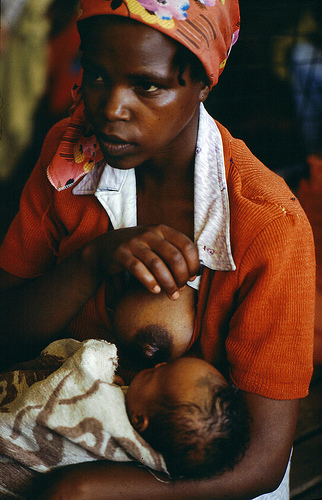
This week has seen an embarrassment of riches for a columnist with my interests. I’ve been torn between the “Gucci Handbags as a means of female-female competition” and the rather tragic unravelling of prominent ‘male feminist’ Hugo Schwyzer.
I hope you will forgive me for trying to find safe ground in an uncontroversial topic: breastfeeding.
One cannot leave a maternity ward these days, even after a short visit to drop off an unimaginitive bouquet and casually impart some unsolicited advice, without forming a strong view of the importance of breastfeeding. The visitors areas, wards, lifts, and even the areas where midwives and new parents nip out for an illicit smoke, all wear a mosaic of public health posters extolling the “Breast is Best” doctrine.
Unsung heroes of public health fight an unwinnable battle to keep mothers breastfeeding as long as they can. Because breast milk is the best available baby food. Except, of course, when it isn’t available. Or when the equipment isn’t working to capacity. Or mum is on certain drugs such as chemotherapy.
Many mothers experience strong external pressure to breastfeed longer than they feel they want to. But should every mother should be entirely self-sacrificing, maximising her breastfeeding tenure or conforming to ‘best practice’ guidelines? This is one of those areas in which some mothers feel their decisions and autonomy come a distant last to the views of in-laws, health-care advocates and even outspoken members of the public.
It is interesting to note, then, that breastfeeding and other ways in which parents invest in their children have been shaped by natural selection. At the heart of decisions such as when to wean a child thrums a tension between the mother’s interests and those of the child. I’ll spare you the mathematics, but suffice to say it usually serves the mother’s interests to feed less, and to terminate breastfeeding at an earlier age, than preferred by the baby. Which is why weaning so often leaves babies bereft and willing to yell about it.
According to evolutionary Parental Investment Theory, the investments parents make in each child should also be shaped by the prospects that child has of growing up, finding a mate and becoming a successful parent themselves. The benefit of having such a child must be offset against the cost to the parent of that care. Producing breast milk and the process of feeding use up time and energy that could be invested in the mother’s existing or future children.
So, younger mothers should invest less in each child instead looking after themselves to ensure they can breed again later on. Older mothers, with less of their child-bearing future ahead of them, should invest relatively more (by breastfeeding longer) in later-born children, as those mothers have less to lose. Mothers should also breast-feed children who are born heavy – with good survival prospects – rather than feeding up low birth-weight children to help them compensate for a slow start in life.
And, the duration of breastfeeding should follow Trivers and Willard’s prediction that high SES parents should favour sons, whereas low SES parents should favour daughters. The Trivers-Willard effect arises because, when women marry ‘upward’, in socioeconomic terms, the daughters of wealthy families and the sons of poor families face especially bleak prospects of ever finding a mate.
This week’s issue of Proceedings of the Royal Society of London B contains a paper that tests exactly these predictions. Katherine Wander and Siobhán Mattison studied the Chagga subsistence farmers of the Kilimanjaro region in Tanzania. They studied the histories of 283 children between 2 and 7 years of age, and explored associations between a number of variables and when each child was weaned.
Seldom do data uphold a theoretic prediction so neatly. Higher socioeconomic status (SES) mothers weaned their daughters earlier than their sons, on average. But the reverse was true in lower SES mothers, consistent with the Trivers-Willard hypothesis.
Later-born children also weaned later. Whereas 20 percent of mothers weaned their first child before it turned 2, only about 7 percent did so for their sixth child. This, again, upholds a theoretic prediction, in this case from life-history theory, that mothers have less to lose from investing heavily in a child born near the end of their child-bearing years.
Intriguingly, too, parents who owned cattle weaned each child later, rather than earlier. This refutes the idea that the availability of other sources of food (in this case cows’ milk) can make weaning more likely.
What can we learn?
When applying evolutionary theory to our own species, one must guard against the ever-present threat of mistakenly inferring what ought to be from the way things are. Just because Tanzanian mothers – or mothers in general – optimise their weaning decisions in relation to evolutionary costs and benefits does not mean they should. Or that breastfeeding guidelines should accommodate the likely evolutionary returns on parental investment.
But I think we could benefit from a more nuanced understanding that breastfeeding and other forms of parental investment happen at the confluence of some fairly divergent interests: mother, child, father, paternal in-laws, maternal in-laws and so on. It is healthy to recognise that mothers can never be all-giving self-sacrificing Madonnas – even when they try valiantly. Breastfeeding, mothering, being a dad or being a grandparent all have their costs.
Which is why we should recognise that important as breastfeeding is to a baby’s development, pressure to do it perfectly and for as long as possible imposes a substantial burden on mothers.
Rob Brooks does not work for, consult to, own shares in or receive funding from any company or organisation that would benefit from this article, and has no relevant affiliations.
![]()
This article was originally published at The Conversation.
Read the original article.

